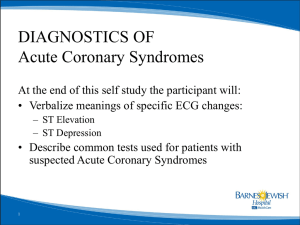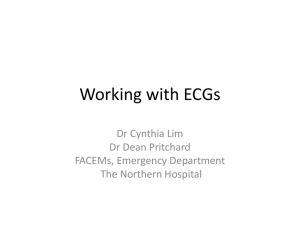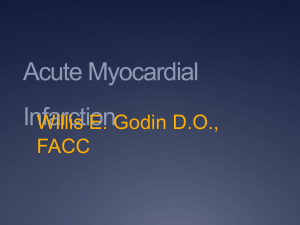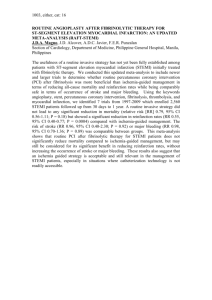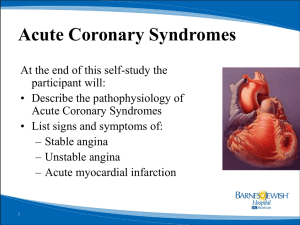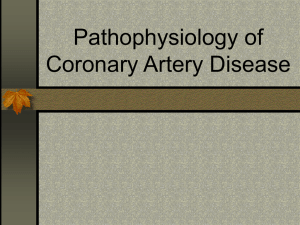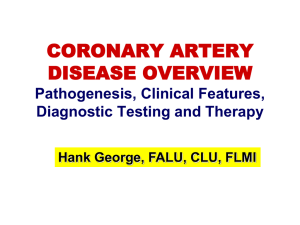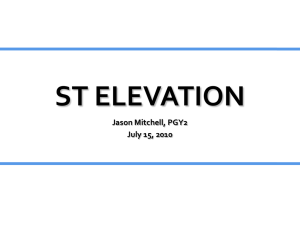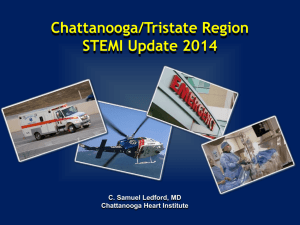Acute Coronary Syndrome Update
advertisement
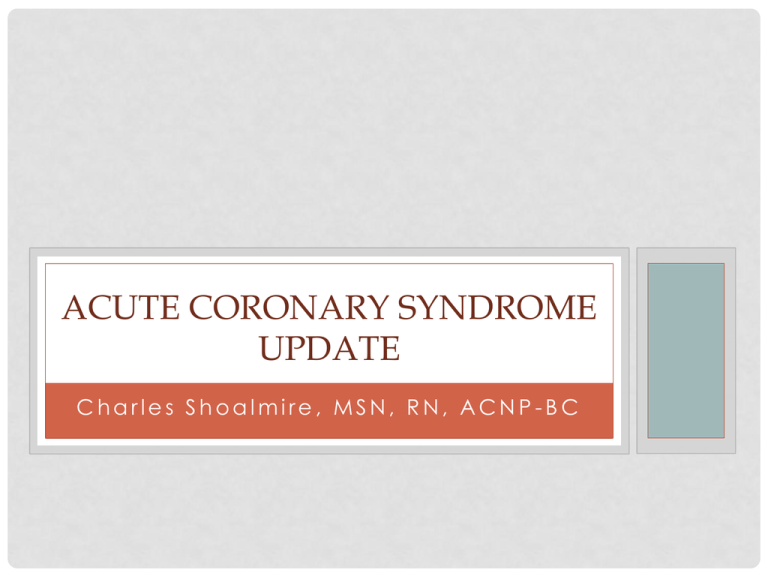
ACUTE CORONARY SYNDROME UPDATE Charles Shoalmire, MSN, RN, ACNP -BC Objectives At the conclusion of this activity, participants will be able to: • Recognize ST elevation MI • Differentiate current subtypes of acute coronary syndrome (ACS) • Discuss appropriate initial treatment algorithm for different subtypes of ACS Definition of Acute Coronary Syndrome • Acute coronary syndrome (ACS) refers to a spectrum of clinical presentations ranging from those for ST-segment elevation myocardial infarction (STEMI) to presentations found in non–STsegment elevation myocardial infarction (NSTEMI) or in unstable angina. In terms of pathology, ACS is almost always associated with rupture of an atherosclerotic plaque and partial or complete thrombosis of the infarct-related artery. http://emedicine.medscape.com/article/1910735-overview Defintion of Acute Coronary Syndrome • In some instances, however, stable coronary artery disease (CAD) may result in ACS in the absence of plaque rupture and thrombosis, when physiologic stress (eg, trauma, blood loss, anemia, infection, tachyarrhythmia) increases demands on the heart. The diagnosis of acute myocardial infarction in this setting requires a finding of the typical rise and fall of biochemical markers of myocardial necrosis in addition to at least 1 of the following: • Ischemic symptoms • Development of pathologic Q waves • Ischemic ST-segment changes on electrocardiogram (ECG) or in the setting of a coronary intervention http://emedicine.medscape.com/article/1910735-overview Universal Definition of MI • ESC/ACCF/AHA/WHF Expert Consensus Document (2012) divides myocardial infarction into five different subtypes: • • • • • • ST Elevation Myocardial Infarction—STEMI—Type I Non-ST Elevation Myocardial Infarction—NSTEMI—Type I Type II Type III Type IV Type V Review of ECG Interpretation Characteristics of STEMI (Type I) • Plaque rupture • Intraluminal coronary artery thrombus formation • Associated ECG changes • Spontaneous MI related to atherosclerotic plaque rupture, ulceration, fissuring, erosion, or dissection – with associated thrombus leading to decreased distal flow and ensuing myocyte necrosis. • This may be – on occasion associated with non-occlusive CAD STEMI on ECG • http://www.virtualmedstudent.com/links/cardiovascular/acute_coronary_syndromes.html&docid=I6WHDB796ClTfM&imgurl=http://www.virt ualmedstudent.com/images/stemi.jpg&w=2558&h=1105&ei=zB3GUIGdDebR2QWIGoCA&zoom=1&iact=rc&dur=494&sig=100654779536327 798686&page=2&tbnh=107&tbnw=248&start=8&ndsp=16&ved=1t:429,r:12,s:0,i:189&tx=128&ty=57 STEMI ECG Criteria • ≥ 2 mm of ST segment elevation in 2 contiguous precordial leads in men (1.5 mm for women) • ≥ 1mm in other leads (2 contiguous) • An initial Q wave or abnormal R wave develops over a period of several hours to days. • Within the first 1-2 weeks (or less), the ST segment gradually returns to the isoelectric baseline, the R wave amplitude becomes markedly reduced, and the Q wave deepens. In addition, the T wave becomes inverted. STEMI ECG Criteria • In addition to patients with ST elevation on the ECG, two other groups of patients with an acute coronary syndrome are considered to have an STEMI: • those with new or presumably new left bundle branch block • those with a true posterior MI • An elevation in the concentration of troponin or CK-MB is required for the diagnosis of acute MI STEMI ECG Criteria • Anterior STEMI: ST elevation in the precordial leads + I and aVL (LAD territory) • Posterior STEMI: reciprocal ST depressions in V1-V3 (ST elevation in post leads), may have component of inferior ischemia as well (ST elevations in II, III and aVF) • Often occurs w/ inferior MI (L Cx) • Inferior STEMI: ST elevation in II. III and aVF (+ ST elevation in R-sided precordial leads), reciprocal changes in I and aVL (R coronary or L Cx) STEMI • http://www.thrombosisadviser.com/html/images/library/atherothrombosis/stemi-andnstemi-ecg-illustration-PU.jpg ECG Challenge • 50 year old male with no known past medical history presents to the ED with new onset left-sided chest pain for one hour. • www.emergencymedicine.ucla.edu/ecgchallenge/ • http://www.emergencymedicine.ucla.edu/ECGChal lenge/MainGUI.html Characteristics of NSTEMI (Type I) • Evidence of necrosis consistent with acute ischemia • A rise and/or fall of cardiac enzyme (specifically troponin I) plus any ONE of these findings meets MI requirements: • Symptoms of ischemia • New (or presumed new) significant ST-segment/T-wave changes OR a new LBBB • Pathological Q waves • Radiologic evidence of loss of viable myocardial tissue at the cellular level OR new regional wall motion abnormality • Intracoronary thrombus by angiography or autopsy Thygesen, K., Alpert, J. S., Jaffe, A. S., Simoons, M. L., Chaitman, B. R., & White, H. D. (2012). Third universal definition of myocardial infarction. Circulation, 126. pp. 2020-2035. doi 10.1161//cur,0b013e3182e1058 Pathologic Q Waves • Any Q-wave in leads V2–V3 ≥ 0.02 s or QS complex in leads V2 and V3 • Q-wave ≥ 0.03 s and > 0.1 mV deep or QS complex in leads I, II, aVL, aVF, or V4–V6 in any two leads of a contiguous lead grouping (I, aVL,V6; V4–V6; II, III, and aVF) • R-wave ≥ 0.04 s in V1–V2 and R/S ≥ 1 with a concordant positive T-wave in the absence of a conduction defect Pathologic Q Waves NSTEMI • http://www.virtualmedstudent.com/links/cardiovascular/acute_coronary_syndromes.html NSTEMI (Type I) • http://www.thrombosisadviser.com/html/images/library/atherothrombosis/stemi-andnstemi-ecg-illustration-PU.jpg Characteristics of Type II • Instance of myocardial injury with necrosis when a condition other than CAD contributes to an imbalance between myocardial oxygen supply and/or demand • Coronary endothelial dysfunction • Coronary artery spasm • Coronary embolism • Tachy-/brady-arrhythmias • Anemia • Respiratory failure • Hypotension • Hypertension with our without LVH Characteristics of Type III • Cardiac death with symptoms suggestive of ischemia and presumed new EKG ischemic changes or new LBBB • Death occurred before cardiac enzymes were obtained or before the values had increased Characteristics of Type IVa • MI associated with PCI defined by an elevation of cTn values of >5X 99th percntile URL in patients with a normal baseline cTn • >20% if the baseline value is elevated and are stable or falling in addition: • • • • Symptoms of MI New ECG changes or new LBBB Aniographic evidence of loss of patency Imaging demonstration loss of viable myocardium or new regional wall motion abnormality Characteristics of Type IVb • MI associated with stent thrombosis detected by angiography or autopsy in the setting of MU with a rise and or fall of cardiac enzymes Characteristics of Type V • MI associated with CABG • Defined by elevation of cardiac biomarker >10x 99th percentile URL in patents with normal baseline values in addition: • New pathological Q waves or new LBBB • Angiographic evidence of new graft or new native coronary artery occlusion • Imaging evidence of loss of viable myocardium or new regional wall motion abnormality. Characteristics of Unstable Angina • The traditional term of unstable angina was first used 3 decades ago and was meant to signify the intermediate state between myocardial infarction and the more chronic state of stable angina. • Unstable angina is considered to be an acute coronary syndrome in which there is no release of the enzymes and biomarkers of myocardial necrosis. Selecting the Appropriate Algorithm • STEMI – preferred treatment in a center with PCI capability: • PTCA with a target door to wire time <90 minutes. • Fibrinolics are an acceptable choice • Medical management for certain patient populations • NSTEMI – primary PCI is acceptable • Medical management is an acceptable choice Non-Pharmacologic Interventions • Percutaneous transluminal coronary angioplasty (PTCA) • Intra-aortic balloon pump • Coronary artery bypass graft (CABG) Pharmacologic Interventions STEMI Fibrinolytics Unfractionated heparin Dual platelet inhibition Beta blockade ACE inhibition for LV dysfunction Consideration of minerocorticoid receptor antagonism for LV dysfunction, e.g. EF < 40% • Spironolactone or Inspra (epleronone) • Statin • • • • • • Non-Pharmacologic Interventions NSTEMI • Percutaneous transluminal angioplasty • Coronary artery bypass grafting Pharmacologic Interventions NSTEMI • Dual platelet inhibition • Aspirin and Plavix or other thienopyridine • • • • Beta blockade Nitrates ACE inhibition for LV dysfunction Consideration of minerocorticoid receptor antagonism for LV dysfunction, e.g. EF < 40% • Spironolactone or Inspra (epleronone) • Statin • Fractionated or unfractionated heparin Treatment of USA • For all practical purposes, the treatment algorithm for NSTEMI is appropriate for unstable angina Conclusion and Questions • Five different categories of MI • Differences on ECG, lab values, etc. • Priority acute treatment for STEMI • Priority acute treatment for NSTEMI • Questions?
